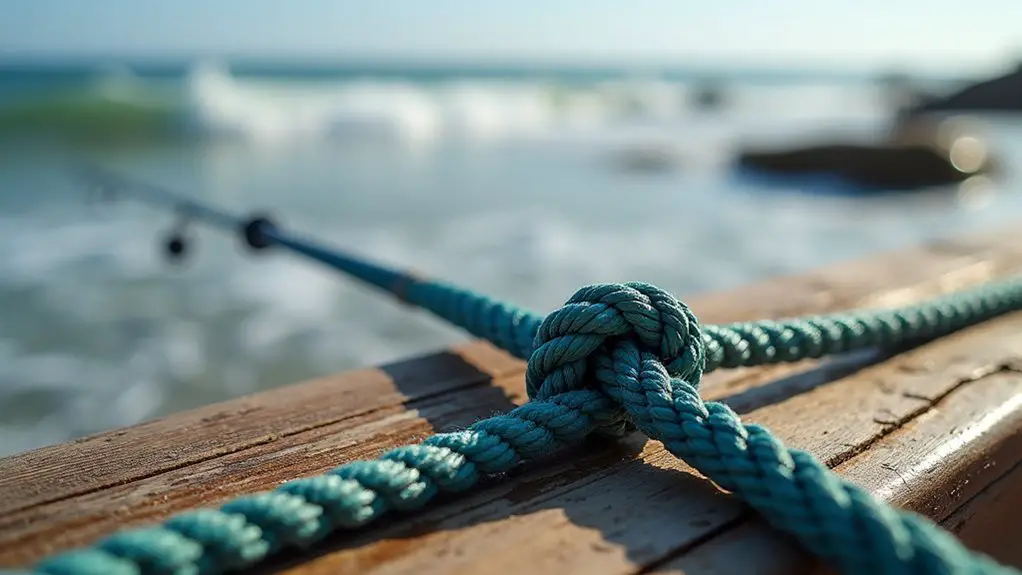For surf fishing success with braided line, you’ll need specialized knots that prevent slippage. The Palomar knot is your best terminal connection (95% strength), while the Double Uni works perfectly for leader attachments. Always wet knots before tightening and consider a drop of super glue for critical connections. Use 6-8 wraps for braid and leave a 1/4-inch tag end. Proper knots mean the difference between landing that trophy or telling another “one that got away” story.
Surf Fishing Highlights
- The Palomar knot maintains braided line strength when tying hooks, requiring 6-8 inches doubled line and proper moistening before tightening.
- Use the Double Uni Knot with 6-8 wraps for connecting braided mainline to fluorocarbon or mono leaders in surf fishing.
- Always wet knots thoroughly before tightening to reduce friction and prevent heat damage to the braided line.
- Leave a 1/4-inch tag end and consider using a tiny drop of super glue for reinforcing critical knot connections.
- Loop knots like the Non-Slip Loop or Palomar Loop enhance lure action in turbulent surf conditions.
Why Braided Line Requires Special Knots for Surf Fishing
While regular fishing line knots might work just fine in calm waters, braided fishing line requires specialized knots that can handle the unique challenges of surf fishing.
Your braid’s slick, stiff surface and near-zero stretch create a slippery situation—traditional knots simply can’t grip properly!
Braided line’s slick profile and zero stretch means standard knots will fail when that trophy fish hits in the surf zone.
Unlike mono, braided line’s multi-strand synthetic composition doesn’t compress well, making knot security a real head-scratcher.
You’ll need knots with extra wraps and locking mechanisms to overcome braid’s notorious slickness.
Remember, the thin diameter that makes braid so appealing also demands knots that can maximize grip.
Without the natural “give” of mono, your knots must hold firm against sudden surf shocks and provide the outstanding sensitivity![]() that makes braided line a preferred choice for detecting subtle bites in surf fishing.
that makes braided line a preferred choice for detecting subtle bites in surf fishing.
The no memory![]() characteristic of braided lines means your knots won’t loosen over time, maintaining their integrity even after repeated casting in rough surf conditions.
characteristic of braided lines means your knots won’t loosen over time, maintaining their integrity even after repeated casting in rough surf conditions.
The Palomar or Modified Uni Knot are recommended options as they provide superior integrity![]() when used with braided lines in challenging surf conditions.
when used with braided lines in challenging surf conditions.
The Palomar Knot: Your Go-To Connection for Braided Line
Among all fishing knots that anglers swear by, the Palomar knot stands head and shoulders above the rest when you’re working with braided line. This powerhouse performer maintains braid’s natural strength while resisting the slippage that plagues lesser knots.
To tie it, double about 6-8 inches of line, pass the loop through the hook eye, tie a loose overhand knot, and slip the loop over your hook. Don’t forget to moisten before tightening! Its design is particularly effective because it allows the hook to rotate freely![]() within the knot. Applying a small amount of Fisherman’s Glue to the finished knot can further enhance its strength for challenging surf fishing conditions.
within the knot. Applying a small amount of Fisherman’s Glue to the finished knot can further enhance its strength for challenging surf fishing conditions.
For slippery braids, try the “Double Palomar” variant—just pass through the eye twice. It’s a game-changer in low-light conditions when other knots leave you fumbling. This approach is similar to the double polymer knot![]() that provides exceptional security when fishing in waters with sharp-toothed predators like pike and muskie.
that provides exceptional security when fishing in waters with sharp-toothed predators like pike and muskie.
Mastering the Double Uni Knot for Leader Connections
The Palomar knot handles your hook-to-line connections beautifully, but now let’s address another critical skill in your braided line arsenal.
The Double Uni Knot is your surf fishing MVP when connecting braided mainline to fluorocarbon or mono leaders.
When joining braid to leader material, the Double Uni Knot delivers tournament-grade reliability that surf anglers can trust in the heat of battle.
- Overlap your lines by 6 inches, creating a parallel highway for your knots.
- Form 6-8 wraps with your braid (it’s slippery, so don’t skimp!).
- Mirror the process with your leader material, creating twin knots facing each other.
- Moisten thoroughly before sliding the knots together—dry friction is your enemy!
Don’t rush this connection—it’s your lifeline to trophy fish! This connection method is particularly effective for saltwater gamefish![]() that make powerful runs when hooked. Remember to test knots under tension
that make powerful runs when hooked. Remember to test knots under tension![]() before heading out to ensure they’ll hold up against powerful surf species. For best results, adjust the number of wraps based on the line thickness
before heading out to ensure they’ll hold up against powerful surf species. For best results, adjust the number of wraps based on the line thickness![]() of your materials.
of your materials.
Albright Knot: Joining Different Line Diameters Effectively
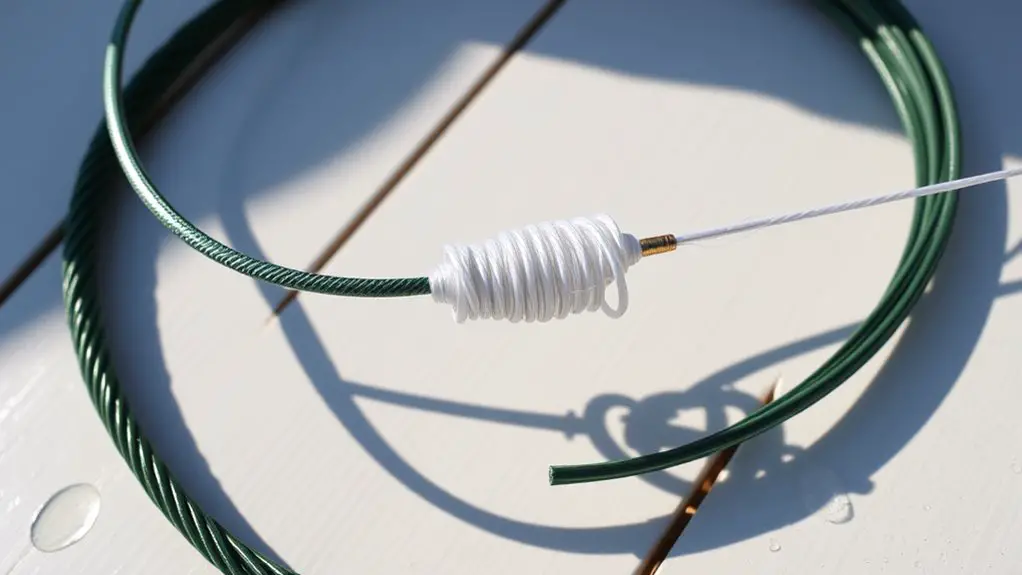
Three critical factors make the Albright Knot an essential weapon in your surf fishing arsenal. It excels at connecting lines of different diameters, eliminates the need for swivels, and maintains impressive strength in challenging surf conditions.
When you’re targeting toothy predators like mackerel or snook, this knot won’t let you down. Form a loop in your thicker leader, pass your braided line through it, and wrap it snugly about 10 times before threading back through. For enhanced security, create a doubled-over wire![]() section at the beginning of your knot construction. Pinch the loop about an inch back
section at the beginning of your knot construction. Pinch the loop about an inch back![]() from the end to provide a stable working area for your wraps. This knot is particularly effective when attaching heavier lines
from the end to provide a stable working area for your wraps. This knot is particularly effective when attaching heavier lines![]() to lighter braided lines commonly used in surf fishing.
to lighter braided lines commonly used in surf fishing.
Remember to moisten before tightening (your knot, not yourself)!
For even greater strength, try the Improved Albright variation with additional wraps—perfect insurance against that trophy fish that’s about to test your connections.
Essential Supplies for Perfect Braided Line Knots
Now that you’ve mastered the Albright Knot, let’s turn our attention to what’s in your tackle box.
Properly equipped anglers tie stronger, more reliable knots with braided line, saving you frustration when that trophy fish strikes.
The right tools transform a frustrating tangle into the perfect connection between you and your next monster catch.
Your essential braided line knot arsenal should include:
- Stainless steel knot tyer tool (prevents slippage and maintains tension)
- Line lubricant (reduces friction and heat during knot tightening)
- Sharp line cutters with micro-tips (creates clean cuts without fraying)
- Protective finger gloves (saves your digits from the “braided line handshake” we all dread)
Many professional anglers rely on tools like the TIE-FAST Original Knot Tyer that offers a safe hook anchor![]() system to prevent painful thumb injuries while managing those sharp hooks.
system to prevent painful thumb injuries while managing those sharp hooks.
The Tie Fast Knot Tool from Boomerang Tool Company is particularly effective for tying nail knots![]() that securely attach your backing to fly line or connect leaders.
that securely attach your backing to fly line or connect leaders.
The HOOK-EZE tool is another excellent option as it provides injury prevention![]() features while helping beginners tie professional-level knots quickly.
features while helping beginners tie professional-level knots quickly.
Step-by-Step Guide to Wetting and Tightening Techniques
Properly wetting and tightening your braided line knots makes the difference between landing that trophy bass and telling another “one that got away” story. Don’t skimp on this essential step!
First, complete all your wraps before applying moisture. Then, wet the entire knot with saliva or water (your choice, no judgment here). This reduces friction that could burn and weaken your line.
When tightening, pull both main line and tag end simultaneously with steady, even pressure. Those coils should stack neatly—think of it as building a tiny fortress against fish escapes.
Avoid that rookie mistake of yanking quickly, which can slice your braid faster than a hot knife through butter. For optimal performance with larger species, aim for 5-10 wraps![]() when tying your knots to achieve the perfect balance between strength and compactness. Remember that braided lines require specific knots like the Palomar or FG knot because of their negligible stretch
when tying your knots to achieve the perfect balance between strength and compactness. Remember that braided lines require specific knots like the Palomar or FG knot because of their negligible stretch![]() properties that make them more slippery than monofilament. Be sure to clean the waxy coating from your braid ends before tying to prevent knot slippage
properties that make them more slippery than monofilament. Be sure to clean the waxy coating from your braid ends before tying to prevent knot slippage![]() during those crucial hook sets.
during those crucial hook sets.
Using Glue to Reinforce Your Braided Line Knots
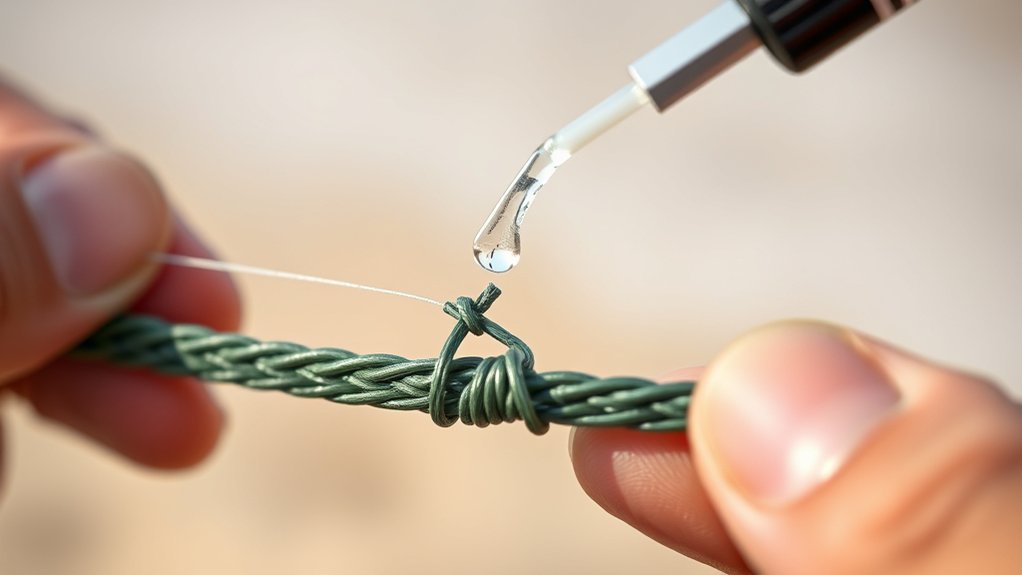
Glue transforms an ordinary knot into a bulletproof connection between you and that trophy fish lurking beneath the surface.
The difference between landing a monster and telling stories about the one that got away often comes down to a single drop of glue.
When properly applied to braided line, cyanoacrylate-based adhesives prevent fraying and considerably reduce slippage without compromising flexibility.
For bulletproof braided knots:
- Leave a 1/4-inch tag end—too short and you’ll have nothing to secure, too long and it’ll catch seaweed
- Apply a tiny drop of fluid super glue (not gel) to the completely dry tag end
- Hold pressure for 5-10 seconds while the glue sets
- Restrict glue use to braid only—mono and fluorocarbon lines can degrade on contact
Testing shows that using super glue can increase knot strength by 10 percent![]() compared to untreated knots.
compared to untreated knots.
Twisting the tag-end around the main line before applying glue creates a more streamlined profile![]() that won’t snag on debris during retrieval.
that won’t snag on debris during retrieval.
Loop Knots for Enhanced Lure Action in the Surf
When fishing the turbulent surf zones, loop knots become your secret weapon for turning stiff, lifeless lures into dancing, fish-attracting powerhouses. They’re essential for braided lines, where traditional knots can create awkward angles that weaken your connection over time.
| Knot Type | Strength Retention | Best Feature |
|---|---|---|
| Braided Loop | 90% | Natural lure movement |
| Non-Slip Loop | 85-90% | Reduced snag potential |
| Palomar Loop | 95% | Easiest to tie in low light |
The Dropper Loop deserves special mention for its perpendicular stand-out quality, perfect when you’re adding weights or multiple offerings. Remember, you’re not just tying knots—you’re engineering freedom of movement!
The San Diego Jam Knot for Terminal Tackle
The San Diego Jam Knot stands as one of the most versatile terminal connections in the braided line arsenal. Born from the demanding offshore tuna fisheries of Southern California, this knot’s reliability in rough surf conditions makes it your go-to choice for securing hooks, jigs, and swivels.
Tying the perfect San Diego Jam Knot:
- Thread line through the eye, create a finger-held loop
- Wrap tag end 6-8 times around doubled line (fewer wraps for heavier braid)
- Pass tag through the double line near eye, then back through your finger loop
- Moisten thoroughly before cinching tight with alternating pulls
You’ll appreciate how this knot maintains nearly 100% line strength while remaining surprisingly quick to tie, even with slippery braid.
Preventing Line Slippage in High-Stress Surf Conditions
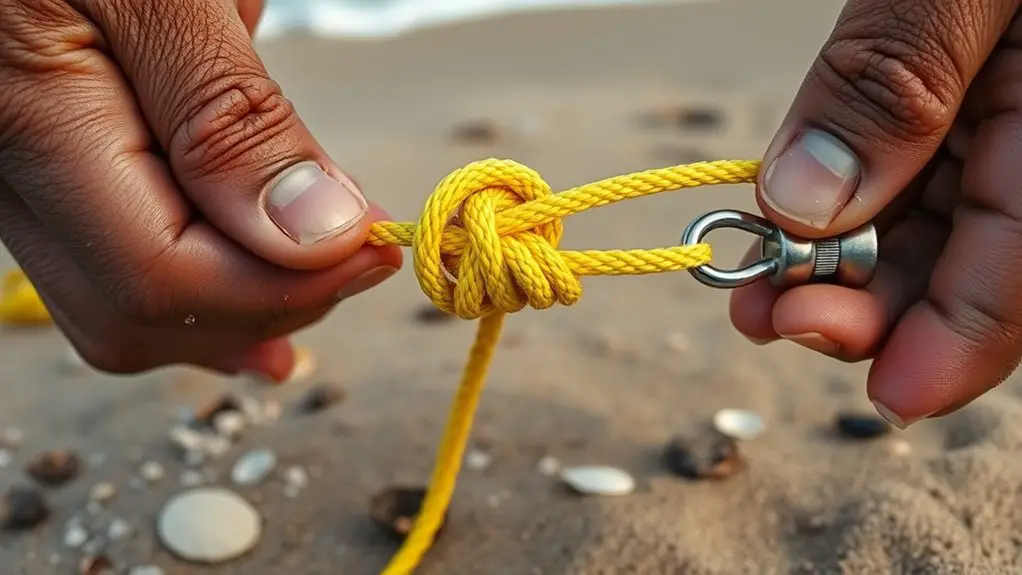
While the San Diego Jam Knot excels at securing your terminal tackle, it’s only half the battle when facing powerful surf conditions.
Your braided line’s slick, waxy texture makes it prone to spinning on smooth reel arbors—a recipe for disaster when a trophy fish hits!
Your best defense? Spool 10-20 yards of monofilament backing first. This grippy foundation (think of it as your line’s best friend!) anchors everything securely.
For bulletproof security, thread your braid through spool holes when available, and maintain rock-solid tension while spooling.
Practice Techniques to Build Knot-Tying Confidence
Mastering braided line knots requires more than just knowing the steps—it demands dedicated practice that builds the muscle memory you’ll need when a monster fish strikes!
Consistent repetition transforms complex knots into reflexive actions that won’t fail when adrenaline is pumping.
Short daily sessions of 10-15 minutes will serve you better than marathon practice once a week.
- Wet your line during practice to simulate real surf conditions
- Record yourself tying knots and review for technique improvements
- Practice with the exact line thickness you’ll use on the beach
- Set specific goals like “three perfect Palomar knots in a row”
Don’t rush—slower, deliberate practice now means faster, confident tying when that dream catch is on the line!
Troubleshooting Common Braided Line Knot Failures
Even experienced anglers face frustrating moments when a perfectly tied knot suddenly fails at the worst possible time—often when that trophy fish is making its final run!
To prevent these heartbreaks, examine your braid for “wind knots” after casting into strong headwinds.
Don’t clip tag ends too short; leave about ¼ inch to prevent unraveling. Always wet knots thoroughly before cinching down, and consider a tiny drop of glue for essential connections.
Check your rod guides regularly for rough spots that might be abrading your line.
Advanced Knot Variations for Specific Surf Fishing Scenarios
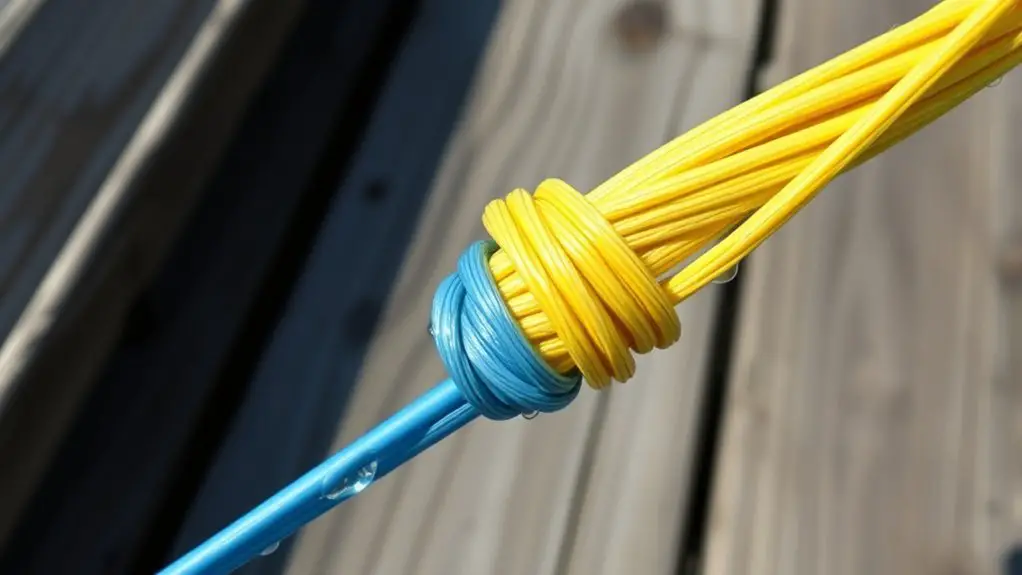
When the surf crashes against the shoreline and powerful fish test your tackle, the standard knots often won’t suffice—you’ll need specialized connections tailored to the unique challenges of surf fishing.
The right knot can mean the difference between a trophy catch and a heartbreaking story.
For surf fishing success, master these variations:
- The FG Knot with extra coils for rough conditions where rocks and shells threaten leaders
- The “wet-finish” Palomar for hooks and jigs when targeting aggressive stripers
- The Albright Special with double wraps for connecting shock leaders in heavy surf
- The Berkley Braid Knot for metal lures when casting beyond the breakers
Frequently Asked Questions
How Long Do Braided Line Knots Typically Last in Saltwater Conditions?
Your braided line knots typically last 2-5 fishing trips in saltwater before needing replacement.
Even strong knots like the Palomar (initially 90%+ strength retention) will gradually weaken from salt, sand, and sun exposure.
You’ll notice deterioration faster in rough surf conditions, where abrasion accelerates breakdown.
Wet your knots before tightening and consider adding a dab of glue for extended life.
Can I Use the Same Knots for Ultralight Surf Fishing Setups?
Yes, you can use the same knots for ultralight surf fishing!
Surprisingly, 85% of knot failures in ultralight setups occur due to improper tightening, not the knot choice itself. Your go-to Palomar knot works wonderfully with thin braids, though you’ll want to add an extra wrap or two.
When connecting to leaders, the Double Uni shines in the skinny stuff. Just remember to wet your line before cinching down—those delicate threads need a little TLC!
How Do Braided Line Knots Perform When Fishing Around Sharp Rocks?
Braided line knots struggle against sharp rocks without proper preparation.
You’ll need to focus on knots like the Palomar or Double Uni, which resist slippage when abraded.
Moistening your line before tightening is essential—it prevents heat damage that weakens the fibers.
For rocky terrain, consider adding a fluorocarbon leader (your line’s bodyguard!) connected with an FG knot.
A drop of glue on finished knots isn’t overkill; it’s insurance against those sneaky rock edges.
Do Colored Braided Lines Require Different Knot-Tying Approaches?
No, your colorful line isn’t secretly plotting to require special knot-tying ceremonies!
Colored braided lines don’t need different knot techniques than their clear counterparts. The same trusty Palomar, Double Uni, and Alberto knots work perfectly well regardless of your line’s fashion choices.
While colored lines might feel slightly stiffer due to pigment additives, you’ll still want to follow standard practices: keep the line moist, make clean wraps, and cinch knots with proper tension.
What’s the Best Way to Salvage a Poorly Tied Knot?
When you’ve got a poorly tied knot, don’t panic!
First, carefully unwrap it using moistened fingers to reduce friction. Trim only the damaged portion of line (waste not, want knot!), and salvage your hook or lure.
Retie using a proper Palomar or Uni knot, ensuring you’ve got the right wrap count for your line weight. Always moisten before tightening, and pull gradually to seat the knot properly.
Your quick fix will have you back to casting in no time!
Conclusion
With these knot techniques in your tackle box, you’ll find yourself hooked on success right where the waves meet your line. Just as the braided threads intertwine to form unbreakable bonds, you’ve now woven together the knowledge needed for those trophy catches. Remember, the difference between “the one that got away” and your best catch ever often comes down to those few inches of perfectly tied knots!

